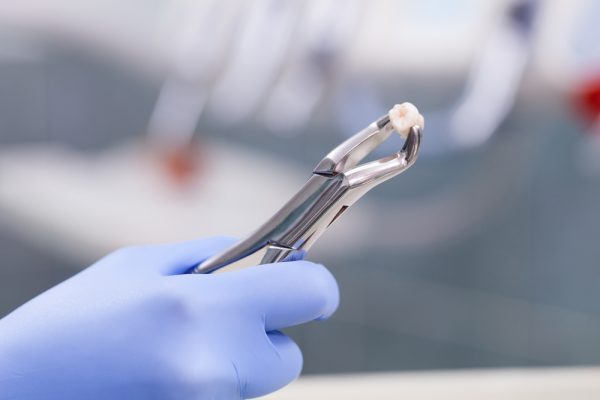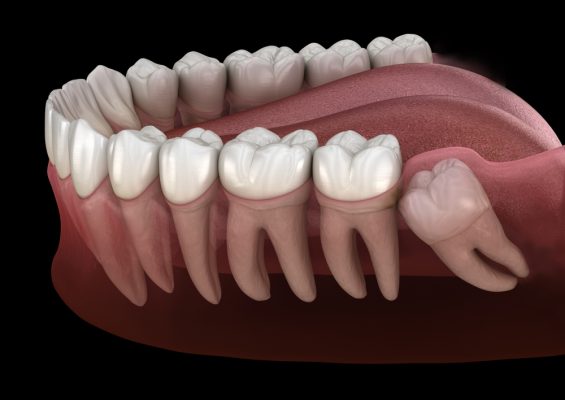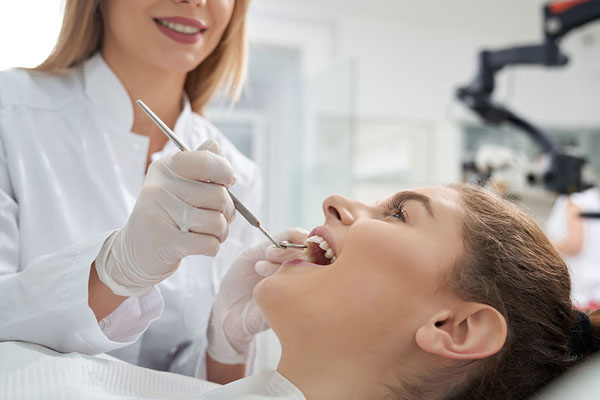Do You Require a Tooth Extraction? 
No patient enjoys hearing they need a tooth removed, but sometimes it’s the best course of action for optimal oral health. At our Matanuska-Susitna Valley dental practice, Dr. Thayne Dawson can gently and skillfully perform tooth extractions, ensuring our patients receive the highest standard of care. To schedule an appointment with our Wasilla, AK, dentist, call us at (907) 373-2440.
What Is a Tooth Extraction?
Tooth extraction, also known as dental extraction and professional tooth removal, is a common procedure involving removing a tooth from its socket. This may be necessary for various reasons, including severe tooth decay or damage, overcrowding, infection, or issues with wisdom teeth.
At Northwind Dental, we prioritize preserving our patients’ natural teeth whenever possible. However, when extracting a tooth is often the ideal solution for protecting your oral health.
Types of Tooth Extraction
Simple Tooth Extraction
A simple tooth extraction or routine extraction, is a straightforward procedure to remove a tooth visible above the gumline. Routine dental extractions are typically performed using a local anesthetic, and the dentist utilizes specialized tools to loosen and extract the tooth gently. Simple extractions are relatively quick and have a fairly short recovery period for most patients.
Surgical Tooth Extraction
Surgical tooth extraction is a more complex procedure required when a tooth is impacted or has not fully emerged from the gums. This surgical procedure may involve local anesthetic and dental sedation, as well as making an incision in the gum tissue to access the tooth.
Surgical extraction is most often needed to address impacted or crowded wisdom teeth. In some cases, the dentist may need to remove bone tissue during the surgical procedure to fully extract the tooth. Surgical extractions often have a longer recovery time, ranging from a few days to a few weeks, and the patient may require prescription pain medication.
Reasons for Tooth Extraction
Tooth extraction can serve as a preventative measure to avoid potential dental complications. Common reasons our Wasilla, AK, dentist performs tooth extractions include:
- Severe Tooth Decay: If a tooth has extensive decay that cannot be repaired with a dental filling, root canal treatment, or other dental treatment, a dental extraction may be necessary to prevent further damage.
- Gum Disease: Advanced periodontal disease can cause the gums to recede and the teeth to loosen, making extraction necessary to halt the progression of the disease.
- Impacted Teeth: Teeth unable to fully emerge from the gums, such as wisdom teeth, can become impacted and cause dental pain, infection, and damage to surrounding teeth.
- Overcrowding: Tooth extraction can create space for orthodontic treatment or address issues with crowded teeth.
- Traumatic Injury: Extraction may be required if a tooth has sustained substantial damage from a traumatic injury.
- Infection: If a tooth becomes infected and the infection spreads to surrounding gum tissue or bone, extraction may be needed to stop the spread of the infection.
- Preparation for Dentures: If a patient requires dentures, extraction of any remaining natural teeth may be necessary to ensure a proper fit and comfortable wear.
The Tooth Extraction Process
Examination and Preparation
The tooth extraction process begins with a thorough examination of the affected tooth and surrounding tissues. During this initial consultation, Dr. Dawson will carefully assess the tooth’s condition, its position in the jaw, and the oral health of the patient. X-rays are typically taken to provide a comprehensive view of the tooth’s roots, surrounding bone structure, and any potential complications that may arise during the extraction.
The dentist will review the patient’s medical history, including any medications they’re taking and any existing health conditions that could affect the procedure. Based on this information, Dr. Dawson will determine the most appropriate type of extraction—simple or surgical—and discuss sedation options to ensure the patient’s comfort throughout the procedure.
Prior to the extraction, patients will receive detailed pre-operative instructions. These may include guidelines on fasting if sedation is to be used, arranging for transportation home after the procedure, and any necessary adjustments to regular medications.
Anesthesia
To ensure a painless experience, local anesthesia is administered to numb the area around the tooth. The process typically begins with a topical anesthetic gel to the gum tissue. This helps minimize discomfort from the subsequent injection of a local anesthetic, such as lidocaine. The dentist will carefully inject the anesthetic around the tooth and wait for it to take effect, ensuring the area is completely numb before proceeding.
For more complex extractions or patients with dental anxiety, dental sedation options may be offered. These can include nitrous oxide (laughing gas), oral sedatives, intravenous (IV) sedation, or in some cases, general anesthesia. The choice of sedation will depend on the complexity of the extraction, the patient’s medical history, and their level of anxiety.
Tooth Extraction Procedure
For a simple dental extraction, Dr. Dawson will use an instrument called an elevator to loosen the tooth from its socket. The elevator is carefully worked around the tooth to separate it from the periodontal ligament. Once the tooth is sufficiently loosened, forceps are used to gently rock the tooth back and forth, further widening the socket until the tooth can be lifted out.
For a surgical extraction, Dr. Dawson will make a small incision in the gum tissue to expose the tooth and surrounding bone. Sometimes, it’s necessary to remove a small amount of bone tissue or to section the tooth into smaller pieces for easier removal.
Tooth Extraction Aftercare
Proper aftercare is crucial for promoting healing and preventing complications after a tooth extraction. Here are some general guidelines for caring for the extraction site:
- Bite Down on Gauze: Gently bite down on a gauze pad for 30 to 45 minutes after the procedure to help stop any bleeding at the extraction site.
- Avoid Strenuous Activities: Refrain from any strenuous physical activities for at least 24 hours following the extraction to prevent bleeding or other issues.
- Take Pain Medication: Follow the dentist’s instructions for taking any prescribed pain relievers to manage discomfort and swelling.
- Apply Ice: Apply ice packs to the affected area for 10 to 20 minutes at a time to help reduce swelling at the extraction site.
- Rest: Take it easy and rest for the first 24 hours after dental extraction, avoiding activities that could dislodge the blood clot.
- Abstain from Smoking: Avoid smoking or using tobacco products for at least 48 hours after dental extraction, as they can impede the healing process.
- Eat Soft Foods: Stick to soft, easy-to-chew foods for the first few days after dental extraction, such as soup, yogurt, or mashed potatoes.
- Rinse with Salt Water: Rinse your mouth with a warm saltwater solution (1/2 teaspoon of salt in eight ounces of water) 24 hours after the dental extraction, and continue this two to three times per day for the next few days. Rinse gently to avoid dislodging or disturbing the blood clot.
- Brush Carefully: Brush your teeth gently, avoiding the extraction site, for the first few days following the procedure.
- Attend Follow-Up Appointments: Keep follow-up appointments with our Wasilla, AK dentist to ensure proper healing and monitor for complications.
Adhering to these aftercare guidelines can help ensure a smooth recovery after tooth extraction. If you experience severe dental pain or any unusual symptoms, contact our Matanuska-Susitna Valley dental practice.
Risks and Complications of Tooth Extraction
While tooth extractions are generally safe and routine procedures, there are several potential risks and complications that patients should be aware of:
Bleeding
Excessive or prolonged bleeding can occur following a tooth extraction. This risk is higher in patients with bleeding disorders or those taking blood-thinning medications Bleeding happens because the extraction process disrupts blood vessels in the tooth socket and surrounding tissues. In most cases, normal blood clotting mechanisms control the bleeding, but sometimes additional measures may be needed.
Infection
Post-extraction infections can develop due to bacteria entering the extraction site. This risk is heightened in patients with compromised immune systems or poor oral hygiene. The open wound left after extraction provides an entry point for bacteria, which can lead to localized infections or, in rare cases, spread to other parts of the body.
Nerve Damage
Nerve damage is a rare but serious complication, particularly in wisdom tooth extractions. The inferior alveolar nerve and lingual nerve are most at risk. Damage can occur if these nerves are stretched, compressed, or severed during extraction. The proximity of the tooth roots to these nerves, especially in impacted wisdom teeth, increases this risk. Symptoms of nerve damage include numbness, tingling, or altered sensation in the lips, tongue, or chin.
Dry Socket (Alveolar Osteitis)
A dry socket is a painful condition where the blood clot that normally forms in the extraction site is dislodged or fails to develop properly. This exposes the underlying bone and nerves, causing severe dental pain. It’s more common in lower molar extractions and in patients who smoke or use oral contraceptives. The exact cause is not fully understood, but factors like trauma during extraction, bacterial contamination, and poor blood supply to the area can contribute.
Damage to Surrounding Teeth or Tissues
During the extraction process, especially for impacted teeth, there’s a risk of damaging adjacent teeth or soft tissues. This can happen due to the force applied during extraction or from surgical instruments. The risk increases with the complexity of the extraction and the proximity of other teeth or structures.
Reactions to Anesthetic
While rare, some patients may experience adverse reactions to local anesthetics used during the procedure. These can range from mild allergic reactions to more severe systemic responses. The risk is higher in patients with a history of allergies or certain medical conditions.
Sinus Complications
For upper molar extractions, there’s a risk of creating sinus cavity complications. This is due to the close proximity of the upper molar roots to the sinus floor. Such a complication can lead to sinusitis or allow fluids to pass between the mouth and sinus.
Jaw Fracture
In extremely rare cases, particularly with the extraction of deeply impacted teeth or in patients with weakened jaw bones, there’s a risk of jaw fracture. This is more likely in older patients or those with certain bone diseases.
Delayed Healing
Some patients, particularly those with certain medical conditions like diabetes or those who smoke, may experience delayed healing of the extraction site. This can prolong discomfort and increase the risk of other complications.
Understanding these risks is crucial for patients undergoing tooth extraction. Discuss any concerns with the dentist before the procedure and closely follow the provided aftercare instructions to minimize the risk of complications. Most extractions heal without incident when proper care is taken before, during, and after the procedure.
Tooth Extraction Cost
The average cost for a basic tooth extraction can vary. The total estimated cost will depend on various factors, including:
- The type of extraction required
- The location of the dental practice
- Your dental insurance coverage
- Any additional procedures needed
- The experience level of the dentist or oral surgeon
- The number of teeth being extracted
Call our office at (907) 373-2440 to learn more about tooth extraction costs.
Frequently Asked Questions
The tooth extraction process is usually not painful, as the area is numbed with a local anesthetic. However, patients may experience some discomfort or pain after the procedure, which can be effectively managed with prescribed pain medication.
Recovery time can vary depending on the individual and the complexity of the extraction. Most people can return to normal activities within a few days to a week, but it may take several weeks for the extraction site to fully heal.
Dentists typically recommend sticking to soft, cool foods for the first few days after the procedure and avoiding anything hard, crunchy, or sticky that could irritate the extraction site.
Many dental professionals suggest replacing missing teeth to prevent issues with chewing, speaking, and the alignment of surrounding teeth. Dr. Dawson can discuss tooth replacement options, such as dental implants, bridges, or dentures, during your consultation.
Safe and Effective Tooth Extractions at Northwind Dental
While our Matanuska-Susitna Valley dental practice always strives to save and protect our patient’s natural teeth, there are times when tooth extraction is the best course of action for their long-term oral health. By removing a severely damaged, infected, or impacted tooth, we can prevent further harm to the surrounding teeth and jaw.
Learn more about the potential benefits of tooth extraction by contacting our Wasilla, AK, office at (907) 373-2440. Serving Wasilla and surrounding areas such as Palmer, Houston, and Anchorage, AK, Northwind Dental is committed to providing safe and effective oral surgery services to ensure your smile stays healthy and beautiful.





